In the most famous wine regions of the world, a tourist wandering the nicely manicured rows of vines that lead up to the front lawn of a gorgeous winery becomes easily lulled into the romantic fantasy of Wine Country.
In Wine Country, life is good. The view is awesome, the people are beautiful, the food is gourmet, the sun is (nearly) always shining, and the wine represents a synergetic artistry—the apotheosis of terroir expression and human craft practiced with exacting detail.
Sometimes, the reality of Wine Country actually comes pretty close to that. This makes it all the more difficult to remember that growing and making wine is a precarious dance done with an unreliable and sometimes entirely unforgiving partner, Mother Nature.
As our current age of climate chaos unfurls, the relationship between winegrowers and the natural world can feel more like a battle these days than a dance.
A Complete Disaster
“It was like a scene from some disaster movie,” says Gideon Beinstock with tears in his eyes recalling the events of several months prior. “We were in a state of complete shock. Fully traumatized. I cried my heart out, and for a few days we were not coherent.”
On April 11, 2022 a severe windstorm swept through the Sierra Foothills of northern Yuba County where Beinstock and his wife farm a few scattered acres of grapes on thin decomposed granite soils amidst spruce, pine, and live oaks at 1500 feet of elevation.
Frost has long been an issue for Beinstock, who farms in a water-poor and fire-prone area of California, eliminating both sprinklers and smudge pots as options for fighting frost. This year, his approach involved wrapping the fruit zone of his newly budding vines with polypropylene fabric in the hopes of creating a warmer air pocket on cold nights.
When the windstorm hit, 40-mile-per-hour winds grabbed this fabric and ripped it partially free, leaving it to swipe and slam its way up and down the tender young growth of Beinstock’s vines.
“It was chaos,” remembers Beinstock. “We were out in the vineyards trying to put this fabric back, and you could watch it scraping all the new buds off, whatever new growth there was on the vine. And then it started to break the trellising.”
Beinstock and his wife frantically worked all afternoon and late into the evening to secure the fabric, but even as they did so, they could feel the temperature dropping precipitously.
“It was a total disaster even before the frost,” says Beinstock, “But by the time we finished getting the fabric back on in the dark, you could already tell there was frost damage beginning. You could take one look and tell it was fucked.”
The next morning, Beinstock and his wife emerged to find utter devastation—a total loss to frost across the entirety of their acreage, including all 1000 of the vines that they had just painstakingly replanted a few months earlier.
Adding insult to injury, 10 days later the region received a late-season rainstorm followed by three nights of more frost.
“Any tiny bit of plant that was trying to come back at that point was re-fried,” says Beinstock, shaking his head. “This year we have literally zero fruit. We can’t even make a quarter of a barrel of wine.”
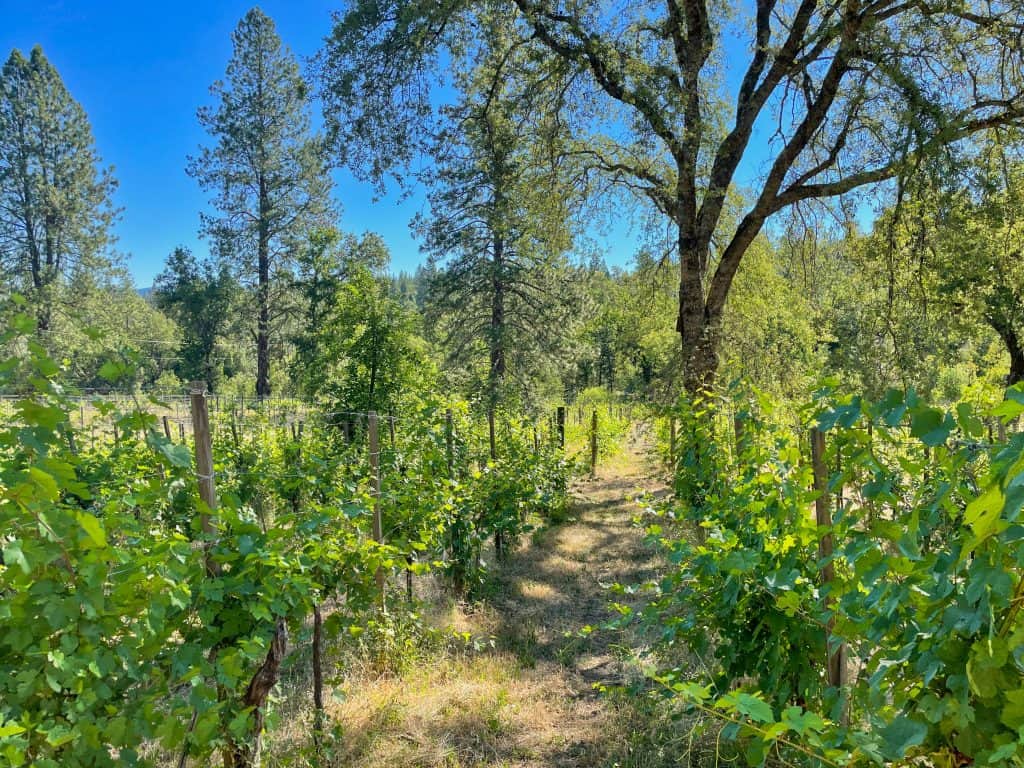
Beinstock buys some of his fruit from fellow growers in the area, not all of whom suffered total devastation as he did. However, their losses ranged from 25% to 50% of their crop, which means they will not have fruit to sell to Beinstock this year.
“How do you start from zero?” asks Beinstock, shaking his head. “We don’t know where to begin.”
The Wine Sage of Yuba County
Perpetually wild-haired and bright-eyed with a ready smile, Gideon Beinstock may be the best California winemaker that most serious wine lovers have never heard of. His obscurity ultimately has less to do with any desire on his part to remain out of the spotlight, and simply more to do with his vision as a winemaker, which comes down to a desire to help a very particular place express itself through wine.
That place is the North Yuba County AVA. For his part, Beinstock doesn’t care much about that official designation (or any appellation for that matter) remaining much more interested in the particular soils, elevation, and climate that happens to be found in this out-of-the-way section of Northern California.
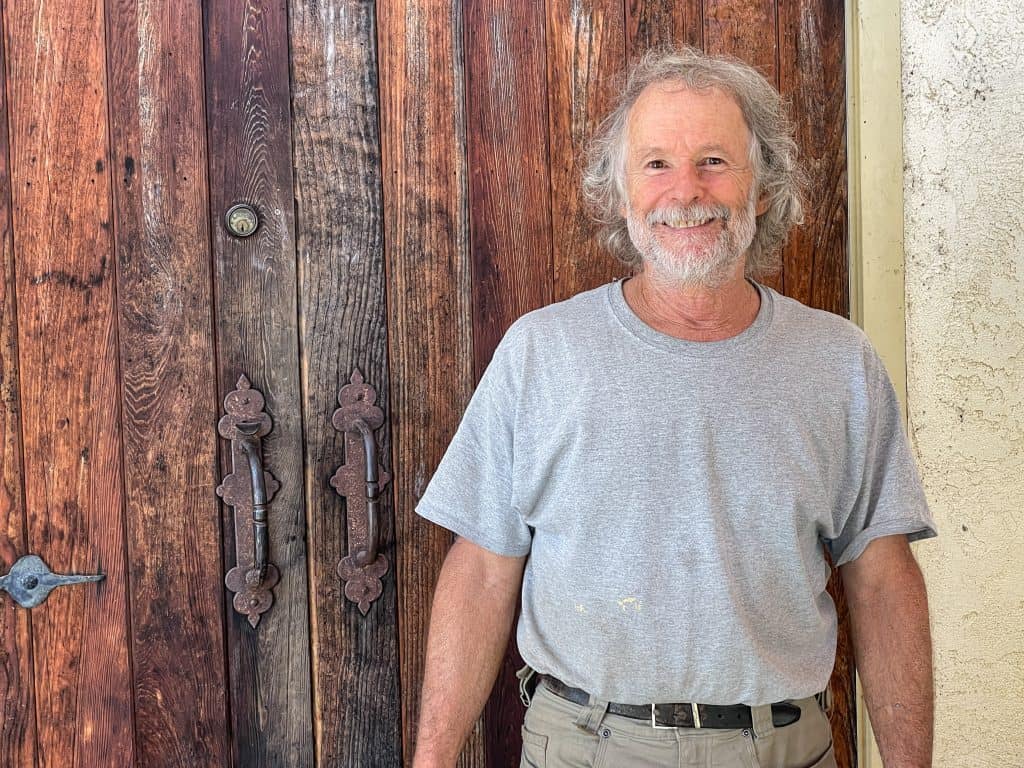
How an Israeli-born artist ended up making some of California’s most terroir-expressive wines in the middle of nowhere turns out to be a story worth telling.
“My father was a military officer, one of the first generation in Israel,” says Beinstock. “I grew up in a tiny, isolated neighborhood outside Tel Aviv. There were maybe 200 or 300 families, and all of them were high brass, or the people that became the high brass in Israel. The founding fathers of the State of Israel were all family friends. Yitzak Rabin used to study French with my mother. The importance of all this is not that I knew all these people, the importance is that I sucked in the values that they lived. I grew up as a product of people who literally built a country from scratch.”
These values, says Beinstock, left him with little fear in life, allowing him to travel and explore different career options, which he says included working for the Israeli security service at Israel’s embassy in Paris, in security for El Al Airlines, and as a computer programmer, all while pursuing his personal passion for painting.
While he was living in Paris two crucial things happened to Beinstock that would end up shaping the rest of his life.
The first was a rapidly deepening appreciation for wine.
“I started studying wine in Paris in the 70s,” says Beinstock, “first just as an avid consumer. I met Spurrier at his store, and started visiting a lot of producers in France.”
The second was an exposure to “The Fourth Way,” an approach to attaining a higher state of consciousness and maximizing human potential developed by Russian philosopher and mystic George Ivanovich Gurdjieff.
Beinstock’s exposure to Gurdjieff came at the hands of a cult that was calling itself the Fellowship of Friends. Beinstock joined enthusiastically, and found, to his surprise, that one of the things this group did was make wine on a sprawling estate in California’s Sierra Foothills.
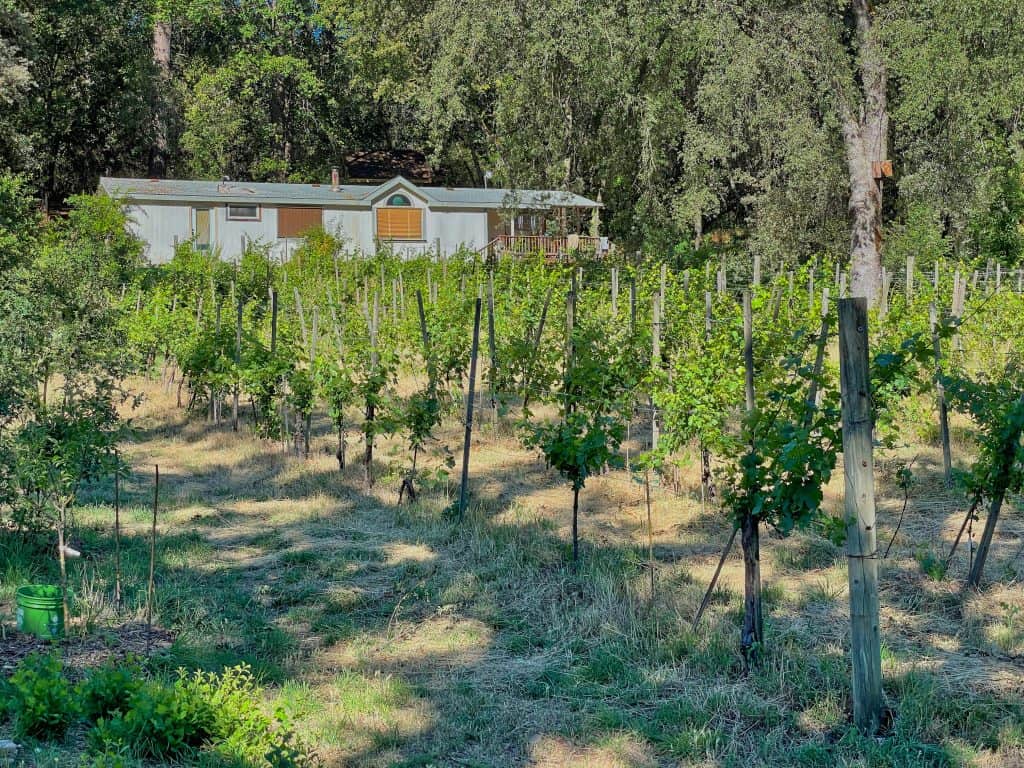
Learning that Beinstock had a passion for wine, the cult asked him to help them sell their wines in Europe in the early 1980s—first from Paris, and later from England where Beinstock would soon move. Once in London, Beinstock ventured even deeper into wine.
“I got involved in tastings for Wine Magazine and at Decanter, I even did some of the MW program,” says Beinstock. “I failed the practical exam, but passed the theoretical exam. I wanted an education in wine.”
By this time it was the early-to-mid 1980s, and Beinstock’s passion deepened with each passing year, as trudged around Europe from train station to train station with wine in tow.
A Door That Must Be Walked Through
One rainy night in London, a 36-year-old Beinstock had to get from Euston Station to King’s Cross Station, and couldn’t get a cab. Dragging his wine boxes in the rain on the long walk, Beinstock found himself grappling with something of an existential crisis.
“I broke down sobbing at one point and just sat down on my wine boxes in the rain,” remembers Beinstock. “What was reverberating in my head was ‘Do I want this? Is this really what I want from my life?’ I knew in that moment that I was at a crossroads, and there was a path I could go down where my life would just be about wine, and that anyone and everyone would equate Gideon with wine from now on. And I also knew that I could just walk away. I think it was a moment when I realized that as you grow up, the decisions you’ve made earlier in your life catch up with you.”
As the lights of London glimmered around him in the wet and dark, Beinstock decided that yes, it would be all wine, all the time.
“My attraction to wine was something I could never explain,” muses Beinstock. “It wasn’t about the taste of wine. It was a deeper infatuation, something about the phenomenon of wine. The fact that wine can be so specific in this expression of place. That to me is something I’ve never experienced anywhere else. By the late 80s, every time I stepped into a vineyard, I started imagining the wine that would come from that place. I was obsessed with vineyards, it was in my blood. There was a beauty in writing computer code, but it involved less of me. As a painter, I knew I was limited, I could improve my skills, but I could not change myself. But with wine, every part of myself felt connected. I knew that I could give up all the earlier things I did in my life without consequences to me or myself, but that wine was a door I had to walk through.”

Around 1980, Beinstock got the opportunity to plant grape vines for the first time, while visiting the cult’s 1300-acre compound just outside of Oregon House, California that was purchased by founder Robert Earl Burton in 1971.
Beinstock would continue to make occasional visits back to the vineyards through the 1980s. In 1991, he decided to move to California, where he asked the Fellowship for the opportunity to make wine, not just sell it. In 1993, Beinstock had the chance to join the cellar crew at Renaissance Vineyards as an assistant.
I have written extensively about Renaissance, and in the process, I’ve related the story of how Beinstock quite literally found himself thrust into the role of sole winemaker for Renaissance, after merely one vintage of helping out in the cellar.
What happened next can’t quite be described without resorting to metaphor or poetry. Without any formal training beyond his tasting and book studies in Europe, Beinstock simply made wine based on his intuition. In doing so, he reached a place towards which his whole existence had been leading. If deciding to devote his life to wine had been walking through a doorway, making his first wines was like breaking through a wall.
“As soon as I saw that first fermentation, I knew I was home,” says Beinstock. “I was melting from the inside out. I am in love with whatever magic happens in that process.”
Finally, Beinstock found himself where he was supposed to be, doing what he was supposed to do. And the wines prove it.
Beinstock’s early vintages at Renaissance, in particular, 1994, 1995, and 1996 are easily some of the most profound, terroir-expressive wines ever made in California, at least to my palate.
Deeply moved by the terroir he had essentially lucked into calling home, Beinstock began planting vineyards around his property in Oregon House, and in 1999, he started making wine under the Clos Saron label, named after his wife, Saron Rice.
California’s OG Natural Winemaker
Beinstock officially made wine at Renaissance until 2010, but 2006 was the last vintage he can stand behind as having been primarily his work. That year also marks his break away from the Fellowship, with which he says he had become increasingly disillusioned beginning as far back as 2000.
Working for the Fellowship as the sole winemaker and the only person in the winery with anything resembling an education in wine gave Beinstock a certain amount of freedom, but it wasn’t his business or his winery.
From the beginning, Clos Saron was the full expression of what Beinstock wanted from the act of winemaking, which, as it turns out is almost nothing at all.
Long before anyone in California had ever heard the term “natural” wine, Beinstock was stripping the winemaking process back to its most essential.
“In 1994 someone dropped a bin of Pinot Noir at the [Renaissance] winery in the middle of harvest, and yelled ‘hey, there’s a bin of Pinot there,’ before driving away,” explains Beinstock. “It was my first full year of making wine by myself and I couldn’t have cared less about a random bin of Pinot with everything else I had going on. I might have foot stomped it, then it got moved somewhere in the winery, and I promptly forgot about it.”
“At the end of the harvest, I said to someone, ‘Hey what happened to that Pinot?’ and they pointed out the bin in the corner that literally hadn’t been touched. We pressed off the very light pink juice, and because we didn’t have enough, we added some Chardonnay, put it in a single barrel, and forgot about it again.”
“By the time we got around to bottling it, the color had deepened. It had length, it had depth, and romantically, it was Pinot Noir. We never sold it. We just drank it. It was ‘our wine’ and it was really a guide for me in my early years. It’s like that Pinot was always there, giggling at me, saying ‘nyah, nyah, you didn’t make me.'”
Beinstock likes to point out that winemaking as we know it is not a necessity, it is a modern invention.
“Winemaking is not one thing,” says Beinstock, “it is many things to many people. But I am stuck on one thing, and that’s the vineyard. The vineyard is everything, so the winemaking must be as close to nothing as possible. I want to remove the winemaker from the picture. I am a radical in this way. You cannot make wines with less steps than I do.”
To that end, Beinstock’s winemaking regimen can easily fit on a 3×5 inch notecard with room to spare.
Grapes are hand harvested in the vineyard and put into a large bin as whole clusters, where they are stomped by foot. After using no sulfur at crush for many years, Beinstock is back to using 35ppm of sulfur dioxide when the grapes come into the winery to avoid mousiness. Other than that bit of sulfur, nothing else is added. No temperatures are controlled. The wine begins to ferment on its own, with ambient yeasts, in its own time.
Once it begins bubbling, whites are pressed into barrel, while reds continue to ferment with their stems. The juice is tasted once per day until the desired level of structure is reached. “I don’t care about color. I don’t pay any attention to color,” says Beinstock, “The mouthfeel is what matters.”
When he senses what he describes as a harmony between weight, density, and the phenolic grip of a wine, Beinstock presses the juice lightly into old oak barrels where it completes fermentation undisturbed and without any additions, not even sulfur. There was a period of time when Beinstock wasn’t even topping-up his barrels, but after some funky results, he returned to topping up barrels every week or two.
When Beinstock deems a wine ready (usually between 14 months and 3 years in barrel) it is racked into a tank, another 35ppm of sulfur dioxide is added, and the wines are bottled without fining or filtration.
So just to recap:
- Harvest
- Foot treading whole clusters before fermentation (+ a little sulfur)
- Press to old oak barrels (top-up regularly)
- Bottling (+ a little sulfur)
“All the steps of conventional winemaking, which are legitimate, are about crafting wine,” says Beinstock. “I’m trying not to craft wine. I don’t want to taste the wine, I want to taste the vineyard.”
Eventually, the natural wine thing “happened” and it became a big deal among the wine cognoscenti and for consumers. All of a sudden, Beinstock found a younger generation of winemakers beating a path to his door, as is depicted in the recent documentary film Living Wine, by Lori Miller.
Despite featuring as the wise old teacher in the film, a role he plays with pleasure for many aspiring young winemakers, Beinstock isn’t quite comfortable being called a natural winemaker.
“When people ask me about the natural wine world, I have mixed feelings,” says Beinstock. “It has made us. In that world we are icons. It is a blessing. [Natural Wine] brings a lot of people into drinking wine and into the industry. Other than that, though, it’s messy. There are a lot of shitty, problematic wines, and people glorify them because they’re natural and ‘natural is good.’ I prefer the description ‘minimalistic winemaking’ rather than natural winemaking. In the winery it is minimalistic. In the vineyard it is anything but.”
Farming With a Dogma Hangover
In a world seemingly full of regimens, Beinstock is just as unconventional in his farming as he is in his winemaking. Organic as a philosophy is his starting point, with no herbicides or pesticides ever used in the vineyards. Like many small winemakers, however, Beinstock can’t be bothered to pay for certification.
The young vines get compost and mulch to help them establish, but when they mature, their only input is water, a necessity in the arid warmth of the Sierra Foothills.
“To control weeds in the winter, we use ducks and sheep, but we don’t really have the infrastructure to let the sheep roam free in the vineyard,” says Beinstock. “Our trellises aren’t strong enough, so at the moment the sheep have to be watched very carefully.”
Beinstock experimented with biodynamic viticulture early on in his farming, long before most people in California had ever heard of it, but he says after 5 years of trying his best he didn’t see any correlation between what he did or didn’t do and the results in the vineyard. Beinstock once told me that he thought biodynamics was just as much of a cult as the Fellowship.
“When you go to biodynamic events, you get this vibe,” says Beinstock. “You behave a certain way, you talk a certain way. It’s a definite cult. It’s certainly not a dangerous one. But look, we were cult members for decades, so we’re a little allergic to that,” says Beinstock.
“It’s not that everything they say is wrong,” he continues, “but if you read Steiner, he doesn’t make any sense. He needs interpreters. And that’s where it starts. We have interpretations, and we get people very identified with their particular interpretation of what the ‘prophet’ said. Danger! Danger!”
“What I see is a correlation between biodynamics and high-quality wine, but the causation isn’t there,” continues Beinstock. “If you spend time in your vineyard every day, you will make better wine.”
Despite his disavowal of any sort of dogma around farming, Beinstock effectively practices no-till, organic viticulture with very few inputs, assisted by animals, which actually makes for something like biodynamic farming minus the official preparations.
When it comes to harvesting grapes, Beinstock again makes his own way, choosing to pick grapes not by chemistry, nor by taste, but by feel. He and his vineyard helpers make multiple passes through each vineyard over the course of weeks, harvesting only the clusters that, when given a gentle squeeze, feel… “right.”
“I had never heard of anyone else doing this,” admits Beinstock. “It didn’t start from any ideological thing. We first decided that we needed to do multiple passes because things just didn’t ripen at the same time and we were spending too much time cleaning up and sorting clusters that weren’t fully ripe. And then with time I just got this sense for how the clusters feel when they are optimally ripe. There’s no point in tasting grapes. Optimal ripeness is not when they taste good.”
“This is so important to making distinctive ‘terroir wines,’ explains Beinstock. ‘The point of optimal ripeness is the only point where every grape expresses fully all the detailed information about its place of origin, the soil, the microclimate, the variety, and the farming. At any other point in the ripening curve, that expression is diluted or masked by elements of under- and over-ripeness, both of which are generic by comparison and interfere with the terroir expression.”
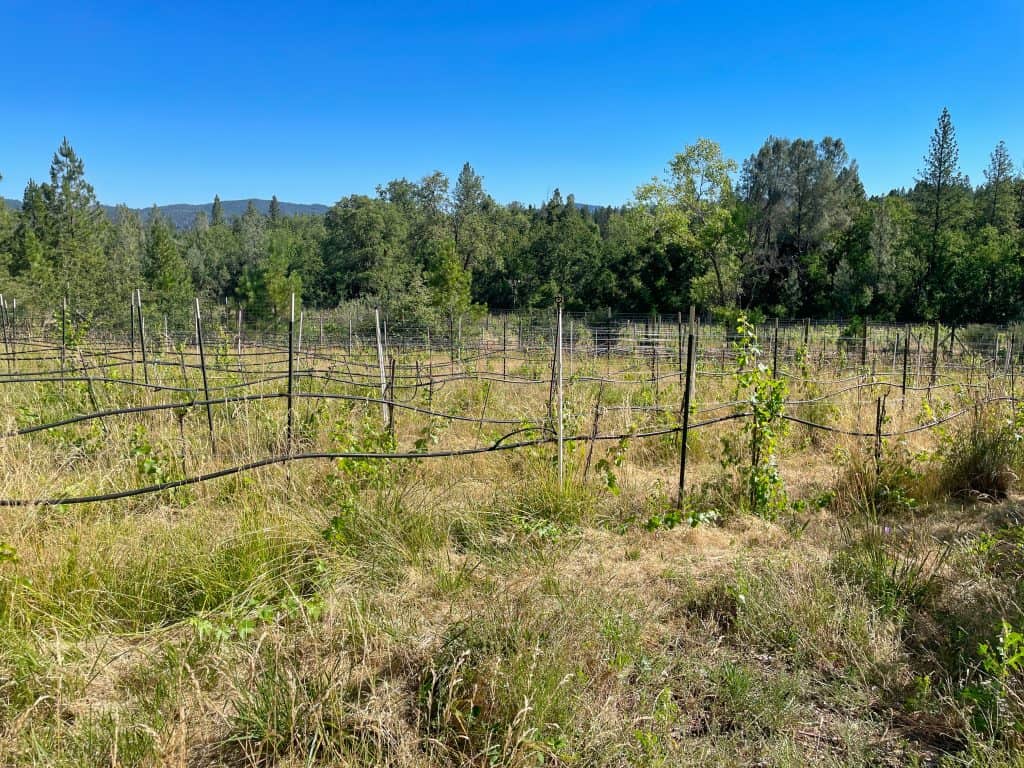
Beinstock has also completely changed his approach to winter pruning in recent years, having learned of a new approach pioneered by Marco Simonit that purports to be much better at preventing Eutypa, a fungus that causes portions of a vine to wither and die, eventually killing the entire vine.
“I’ve been pruning vines for 40 or 45 years. I am well-trained,” says Beinstock. “But I started watching these videos and they blew my mind. They showed me everything I have been doing is wrong. We realized that we’ve been inflicting severe wounds on the vines on a yearly basis. Is it any wonder that we have an epidemic of vine trunk disease around the world? This new approach respects the sap flow of the vine, and in some cases has completely revitalized and regenerated older, diseased vines.”
Putting the Micro in Micro Production
At its peak of production, Clos Saron was producing around 1000 cases of wine each year from around 8 acres of owned and leased vines, and roughly 50% purchased fruit. These days, with two of those leased acres no longer available and less purchased fruit, production hovers around 400 cases a year, the depressing absence of wine in 2022 notwithstanding.
The roughly 6 to 10 tons of fruit that Beinstock might processes each year goes to making a surprisingly wide array of wines, given such a small quantity of fruit. The typical lineup involves 4 different Pinot Noirs, a couple of Syrahs, a Zinfandel, a Tannat, two white wines, and a couple of rosés. Having said that, over the last 20 years, Beinstock has made a bunch of wines based on fruit that he gets for one or two vintages, and then never again. Every time I think I’ve finally heard of all the wines that Beinstock has made, another one pops up on my radar, usually with a whimsical name that seems to be one of Beinstock’s hallmarks.
The latest addition to his lineup is an unusual white field blend of Loire, Teutonic, and Rhône grape varieties from just below his house that he calls The White Field, which he makes with a few days of skin contact, and in microscopic quantities (think: less than 200 bottles).
Clos Saron wines are idiosyncratic and occasionally flirt with eccentricity. On occasion, they feature a little volatile acidity, and every once in a blue moon, a little Brettanomyces yeast. Generally, though, they are clean, if a little rustic. At their best, they are beautifully honest, unvarnished, and deeply expressive of the granite on which most of them grow.
Every time I taste a group of Clos Saron wines I am invariably brought up short by one wine or another, which seems to crystallize in the glass and transmit in that moment something quite profound about the place from which it comes. I find it mysteriously amusing (if not slightly maddening) that it is not always the same bottling that does this to me, though I will admit a perpetual fondness for Beinstock’s Syrahs, which I think are among the best of what he does.
Aficionados of natural wines will (and do) devour every one of Beinstock’s wines with delight. For those with less tolerance for wines with rough edges, some Clos Saron wines may lean a little savory or a little wild. If you’re interested in tasting somewhereness, however, there are few wines in California that so consistently deliver it.
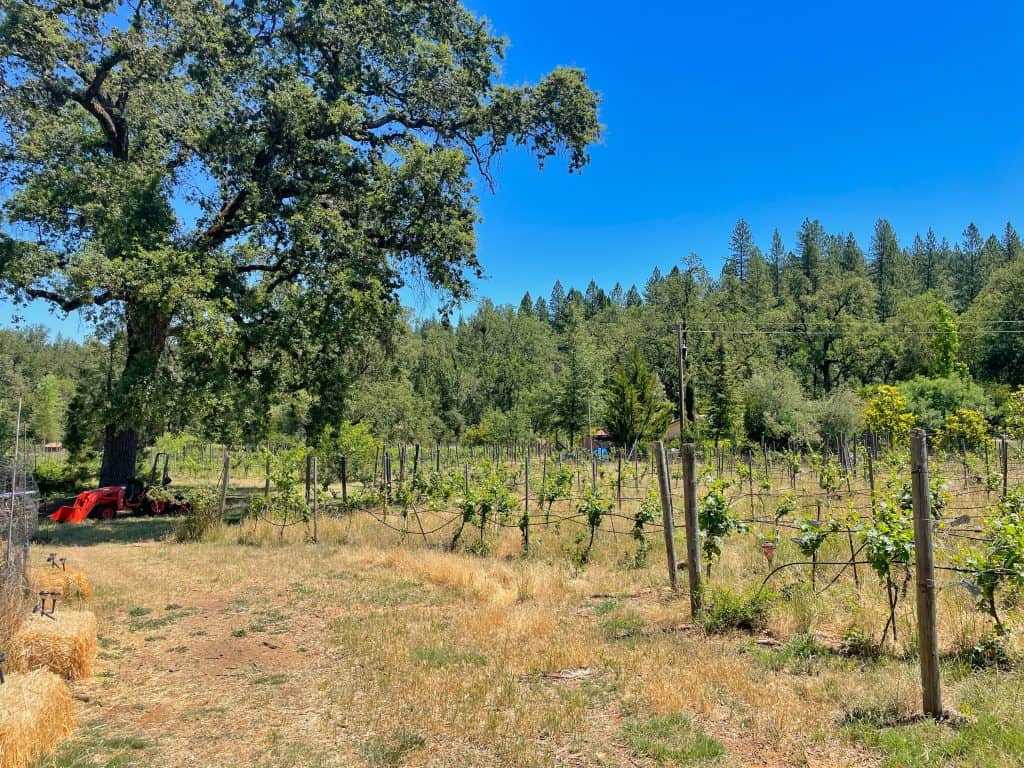
An Uncertain Future
Facing the total loss of a vintage has accelerated conversations and thinking with which Beinstock and his wife were already beginning to grapple as the years have marched on. None of their adult children have expressed interest in taking over the vineyard operation. Even with interns and seasonal help, 7 acres is proving difficult to farm properly as the couple ages, even when nature fully cooperates.
As we sat under the oak tree that shades the vines in front of his house and tiny winery this summer, Beinstock seemed (understandably) a little unmoored as he reeled off all the options that he and Saron have considered in the face of this recent disaster: making piquette, buying grapes from somewhere else in the state, taking on partners with money to buy other vineyards, making “easy wines” while slowly selling the substantial library stock of wines they’ve built up—the list went on and on.
None of these options, however, provides much in the way of retirement security for Beinstock and his wife, something they’re thinking more about, especially in the face of an increasingly hostile climate.
“The vineyard is too small to lease to someone, and its sale price is near worthless,” says Beinstock. “We have two other worthless structures here. We could probably sell it all, but [the proceeds] wouldn’t really allow us to just retire, and we don’t really want to move away from our friends here.”
Beinstock shakes his head and returns, perhaps knowingly, to the metaphor of a crossroads. “We made choices earlier in life, and we have to live with the consequences. Many of those choices were positive. I would do all this again. We’re here for another 4 to 6 years for sure, maybe further, maybe not. The question of being burned is not if, but rather when. So far we’ve been spared, but how long does that luck last?”
Within an hour of Beinstock making this statement, we see a huge plume of smoke rising from the nearby hills—what would become the Rices Fire, a blaze that would go on to scorch nearly 1000 acres and come within a couple of dozen miles to their home.
“For me,” says Beinstock, “wine is becoming the least interesting thing here, in a way. What’s more interesting is the question of what do you make of your life in these times? We’re living on the titanic as it’s sinking in slow motion.”
These questions may not have ready answers, either for Beinstock or the rest of us. But they make me think of Beinstock’s pithy description of his childhood: “We had no money, and we were surrounded by adverse conditions. And we thrived.”
Somehow, I suspect Beinstock will find his own way, just as he always has. Granite endures.
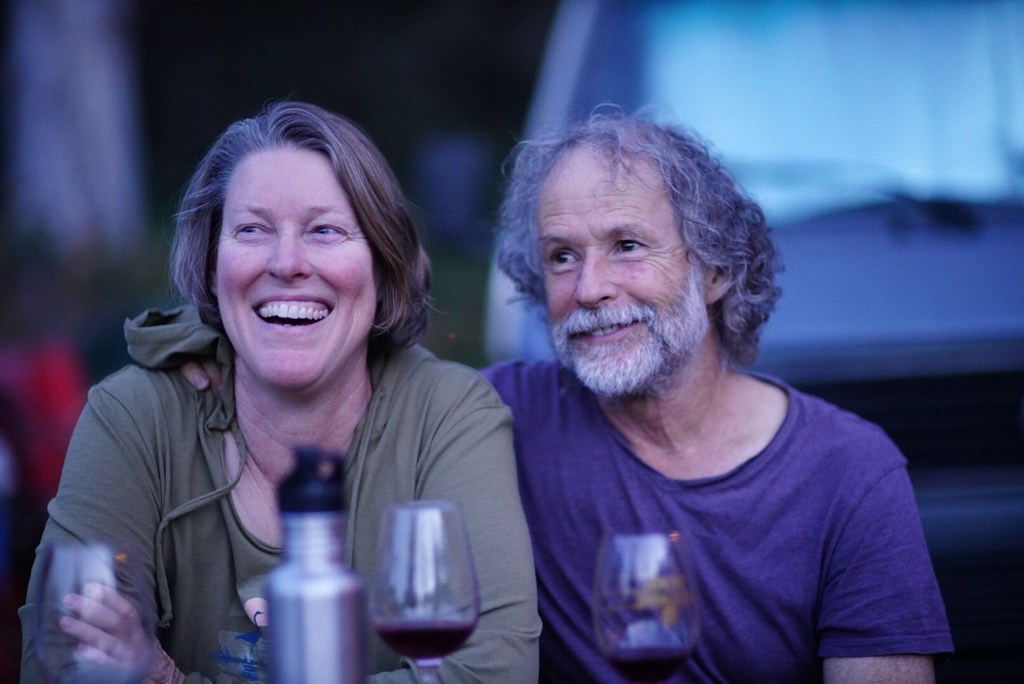
Tasting Notes For Current Releases
2019 Clos Saron “Tickled Noir” Rosé of Pinot Noir, Sierra Foothills, California
Pale coppery gold in the glass, this wine smells of rosehips and citrus peel, and a hint of acidophilus tang. In the mouth, wonderfully bright sour cherry and raspberry flavors mix with rosehips and a nice wet stone quality. There’s a sour cherry acidophilus note that lingers in the finish. 11.5% alcohol. Foot stomped and then pressed. No real maceration here. Score: between 8.5 and 9. Cost: $75. click to buy.
2016 Clos Saron “Tickled Pink” Rosé, California
A light amber-pink in the glass, this wine smells of dried flowers, dried fruit skins, and wet leaves. In the mouth, dried apple and berry flavors are welded to a deep stony minerality with hints of sour cherry, apricot, and citrus peel. Long finish and fantastic acidity. A blend of 65% Merlot and 35% Viognier, but the percentage of each changes every year. As time has gone on, this wine is getting released older and older, with the target eventually being 8 years after the vintage. 12% alcohol. Score: around 9. Cost: $55. click to buy.

2020 Clos Saron “Carte Blanche” White Blend, California
A cloudy, chunky pale orange in the glass, this wine smells of orange peel, a hint of cheese, and a salty, creamy note. In the mouth, saline flavors of citrus peel, a faint cheesy quality, and wet stone are bright and tangy. A field blend of Albariño and Verdelho. 12% alcohol. Gets at least 4 days of maceration, probably 5 or 6 on average. Score: around 8.5. Cost: $52. click to buy.
2018 Clos Saron “The White Field” White Blend, Sierra Foothills, California
Light amber gold in the glass, this wine smells of pennyroyal and wet leaves, wet stone, and orange peel. In the mouth, Ranier cherry, orange peel, wet earth, a hint of flowers, and herbs with excellent, kumquat acidity. Delicious with a hint of salinity. 24% Roussanne, 32% Riesling, 19% Viognier, 12% Sauvignon Blanc, 3% Petit Manseng. 12% alcohol. 144 bottles made. Gets about 4 to 7 days on the skin. Score: between 9 and 9.5. Cost: $75. click to buy.
2019 Clos Saron “Black Swan” Zinfandel, Sierra Foothills, California
Medium garnet in the glass, this wine smells of blackberries and dried flowers. In the mouth, stony blackberries, sour cherries, and pulverized stone. Perhaps the stoniest Zinfandel I’ve ever tasted. And that’s a good thing. 13% alcohol. Comes from a small vineyard in Nevada county at 2900 feet of elevation planted on decomposed granite. This is what happens to Zinfandel when you treat it with respect. Nothing jammy or thick or clumsy about this. Score: between 9 and 9.5. Cost: $48. click to buy.
2019 Clos Saron “Cuvee Mysteriuese” Red Blend, Sierra Foothills, California
Dark garnet in the glass, this wine smells of crushed stone and a hint of volatile acidity. In the mouth, powdery stony tannins sit like a haze surrounding cherry, berry, and a sourish yogurty tang. Juicy with great acidity. 12.9% alcohol. A field blend planted on decomposed granite at 2200 feet of elevation. Syrah, Cabernet Franc, Merlot, and Zinfandel are co-fermented. 1535 bottles made. Score: between 8.5 and 9. Cost: $50. click to buy.
2017 Clos Saron “Tête a Tannat” Tannat, Sierra Foothills, California
Medium ruby in the glass, this wine smells of black cherry and blackberry with a hint of earth. In the mouth, tangy black cherry, unripe blackberry, and crushed stone have a tangy umami character and a bitter yerba mate note in the finish. Also from a defunct vineyard in Nevada county that has since been sold, so this wine will no longer be made. 90% Tannat with 10% Cabernet Sauvignon. 588 bottles made. Score: around 8.5. Cost: $75. click to buy.
2017 Clos Saron “Home Vineyard” Pinot Noir, Sierra Foothills, California
Light to medium ruby in color, this wine smells of red apple skin, wet leaves, and mulling spices. In the mouth, redcurrant, cedar, wet leaves, citrus peel, and dried flowers have a deeply stony, powdery tannic texture and great citrus peel acidity. Not like any other Pinot Noir made in California, but Gideon would probably say, that is precisely the point. Deeply mineral. 1140 bottles made. 13.3% alcohol. Score: around 9. Cost: $65. click to buy.
2014 Clos Saron “Old Block” Pinot Noir, Sierra Foothills, California
Light garnet in the glass, this wine smells of redcurrant, a hint of old socks, wet stones, and raspberry. In the mouth, raspberry and raspberry leaf mix with red apple skin, redcurrant, and powdered stone. There’s a volcanic tannic grip to this wine. Powerful, deep, and stony. Tangy redcurrant and amazing acidity linger in the long finish. This wine only gets made when there are 800 pounds of fruit that can be harvested in a single pass through the vineyard. The goal is to release it 10 years after the vintage. 660 bottles made. 13.1% alcohol. Score: between 9 and 9.5. Cost: $90. click to buy.
2017 Clos Saron “Stone Soup” Syrah, Sierra Foothills, California
Dark garnet in color, this wine smells of iodine, rust, and black fruit. In the mouth, intensely stony flavors of cassis, sour cherry, black cherry, and citrus peel are shot through with stony tannins. There’s a hint of volatile acidity in this wine, but that gives it a bright juiciness. It’s hard to explain just how much stone comes through in the glass. Still young yet. Contains roughly 10% Viognier. This is often my favorite bottling from Clos Saron, but sadly, Beinstock is no longer farming this vineyard. 12.9% alcohol. 1390 bottles made. Score: between 9 and 9.5. Cost: $60. click to buy.
1997 Clos Saron “Once Upon a Time Heart of Stone” Syrah, North Yuba, Sierra Foothills, California
Light ruby in the glass with hints of brick, you’d think this was a Pinot Noir by color. This wine has a cidery note to its aroma. In the mouth, balsamic VA notes mix with cider, and dried fruit. There’s a creamy note to the finish that suggests oxidation. 100% Syrah from Renaissance Vineyards. 60 bottles made. Score: between 8 and 8.5. Cost: $??
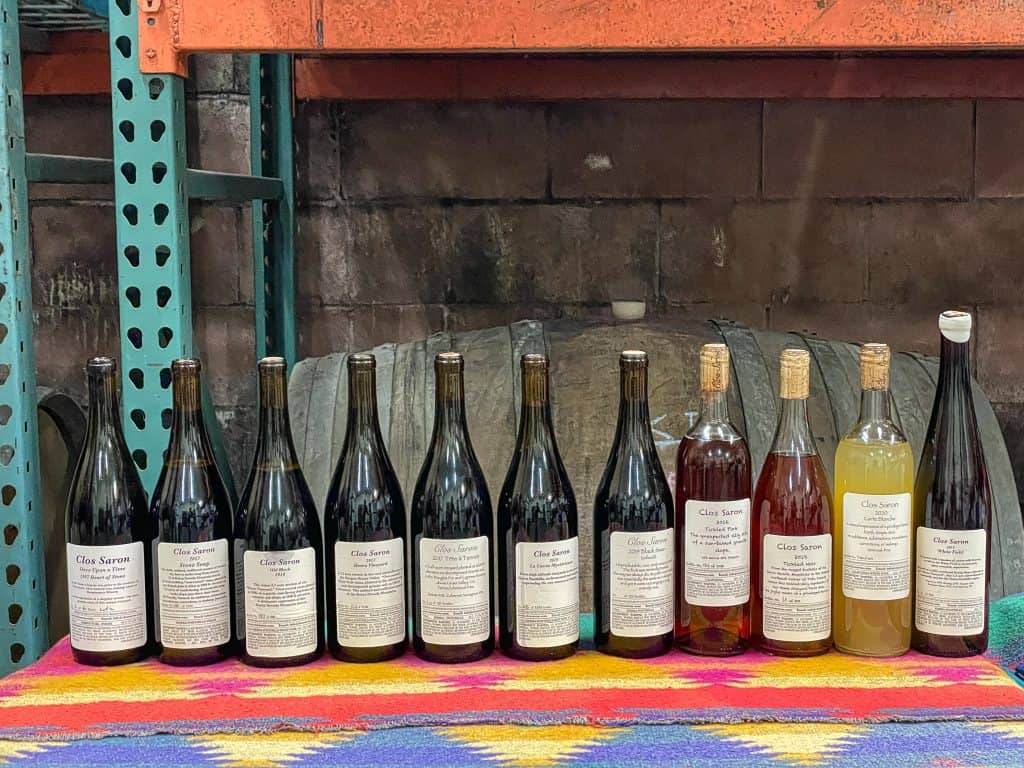
Tasting Notes for Past Releases
2014 Clos Saron “Carte Blanche” White Blend, California
Light yellow-gold in the glass, this wine smells of peach jam and white flowers. In the mouth, bright peach and apple flavors have a slightly herbal quality to them and a faint aromatic sweetness. Moderate acidity. A 50-50 blend of Albariño and Verdelho grown on decomposed granite. 12.8% alcohol. Score: around 8.5. Cost: $85. click to buy.
2013 Clos Saron “Tickled Pink” Rosé, California
Pale salmon pink in the glass, this wine smells of strawberries, wet stones, and peaches. In the mouth, bright strawberry and watermelon rind mixed with a peachy flavor that has a nice silkiness and bright acidity. Great crisp length. A blend of 38% Syrah, 38% Graciano, and 24% Verdelho.11.9% alcohol. Score: around 9. Cost: $55. click to buy.
2011 Clos Saron “Lower Block” Pinot Noir, Sierra Foothills, California
Medium garnet in the glass, this wine smells of wet chalkboard, mulling spices, and black raspberry fruit. In the mouth, perfumed black raspberry fruit mixes with blueberry and crushed green herbs for a very aromatic and pretty complexity on the palate. Excellent acidity and length. Quite distinctive and pretty. 13.5% alcohol. Score: around 9. Cost: $??
2012 Clos Saron “Home Vineyard” Pinot Noir, Sierra Foothills, California
Medium garnet in the glass, this wine smells of wet leaves and boysenberry fruit. In the mouth, black raspberry and redwood bark flavors mix with wet leaves and a hint of river mud. There’s also a sort of green dandelion milk flavor to the wine that is quite unusual. Good acidity. Chalky tannins remain with a mineral quality in the finish. 13.2% alcohol. Score: around 8.5. Cost: $75. click to buy.
2011 Clos Saron “Old Block” Pinot Noir, Sierra Foothills, California
Medium garnet in color, this wine smells of cranberry, raspberry, and redwood bark. In the mouth, bright acidity brings a zippy juiciness to flavors of raspberry, cranberry, and mulberry. Crushed stone and redwood bark mix with the darker earth flavors that linger in the finish. 13.2% alcohol. Score: between 8.5 and 9.
2010 Clos Saron “A Deeper Shade of Blue” Red Blend, North Yuba, Sierra Foothills, California
Medium garnet in the glass, this wine has a wonderfully floral nose of blueberry aromas. In the mouth flavors of blueberry, black cherry, and wet stones dance with fantastically bright acidity that gets the taste buds working overtime. Excellent balance and nice length. An unusual blend of Cinsault, Syrah, and the white grape Roussanne. Score: around 9.5. Cost: $32.
2014 Clos Saron “Blue Cheer” Red Blend, California
Medium bright purple in the glass, this wine smells of mulberry and cassis and black cherry. In the mouth mulberry and black cherry fruit have a bright zingy quality that is, yes, cheerful. Faint tannins and herbal notes hang in the background along with a deeper mineral quality. A 50-50 blend of Cinsault planted in 1886, and Carignan planted in 1900. 13% alcohol. Score: around 9.
2014 Clos Saron “Out of the Blue” Cinsault, California
Medium purple in the glass, this wine smells of beautifully perfumed mulberries, lilacs, and crushed stones. In the mouth, the wine has beautifully juicy mulberry and black cherry fruit that positively bursts on the palate thanks to fantastic acidity. A deep crushed stone minerality backs it up, and hints of flowers and herbs linger in the finish. Contains 2% Syrah. 13.4% alcohol. 200 cases made. Score: between 9 and 9.5.
2007 Clos Saron “Heart of Stone” Syrah, North Yuba, Sierra Foothills, California
Dark garnet in the glass, this wine has a nose of meaty, savory, tangy acidophilus aromas. In the mouth flavors of red apple skin, leather, and sour cherries have a wonderful juiciness to them thanks to fantastic acidity. With an enthralling twist, the wine turns darker as it lengthens on the palate, with blackberry flavors and wet earth lingering long after each swallow. Score: around 9.5. Cost: $120. click to buy.
2009 Clos Saron “Heart of Stone” Syrah, Sierra Foothills, California
Very dark garnet in the glass, this wine smells of sweetly perfumed cassis, lilac, and leather. In the mouth, the wine is gorgeously textured with fantastic muscular-yet-velvety tannins that cradle a juicy, SweetTart-bright mixture of cassis, black cherry, and oiled leather on top of which sings a bright floral note, likely thanks to the 10% cofermented Viognier. Deeply mineral with herbal notes and pulverized rock flavors that linger through the long finish. Outstanding. 13.8% alcohol. Score: around 9.5. Cost: $130. click to buy.
2010 Clos Saron “Stone Soup” Syrah, North Yuba, Sierra Foothills, California
Medium garnet in the glass, this wine smells of floral aromas and sweet cassis fruit. In the mouth flavors of cherry, juicy cassis, and wet earth have a wonderfully dynamic punch to them thanks to extraordinarily bright acidity. Notes of bergamot filter through the wines great length, as powdery tannins coat the mouth. Excellent. Score: around 9.5. Cost: $56. click to buy.
2012 Clos Saron “Stone Soup” Syrah, Sierra Foothills, California
Very dark garnet in color, this wine smells of beautiful cassis, violets, and white pepper. In the mouth, powdery muscular tannins wrap around a core of blueberry and cassis fruit shot through with white pepper and crushed herbs. Deeply savory, with a hint of saline quality in the finish married to the crushed stone minerality. Roughly 13% alcohol. Score: around 9. Cost: $ . click to buy.
2009 Clos Saron “Cuvée Mystériuese” Red Blend, Sierra Foothills, California
Medium garnet in color, this wine smells of mulberry, cassis, and white flowers. In the mouth, mulberries, crushed stones, white flowers, and green herbs have a nice savory balance to them. Nice finish and great acidity, with faint but muscular tannins. An unusual blend of Syrah, Merlot, and Viognier. 13.4% alcohol. Score: around 9. Cost: $110. click to buy.
2009 Clos Saron “Black Pearl” Red Blend, Sierra Foothills, California
Dark garnet in the glass, this wine smells of herbs, cola, mulberry, and cassis. In the mouth, juicy bright mulberry, cola, cherry, and a hint of green tobacco flavors are layered over a deep crushed stone minerality. There’s a very pretty aromatic sweetness. An unusual blend of Syrah, Cabernet, Petite Verdot, and Sauvignon Blanc. 13.5% alcohol. Score: around 9. Cost: $120. click to buy.





